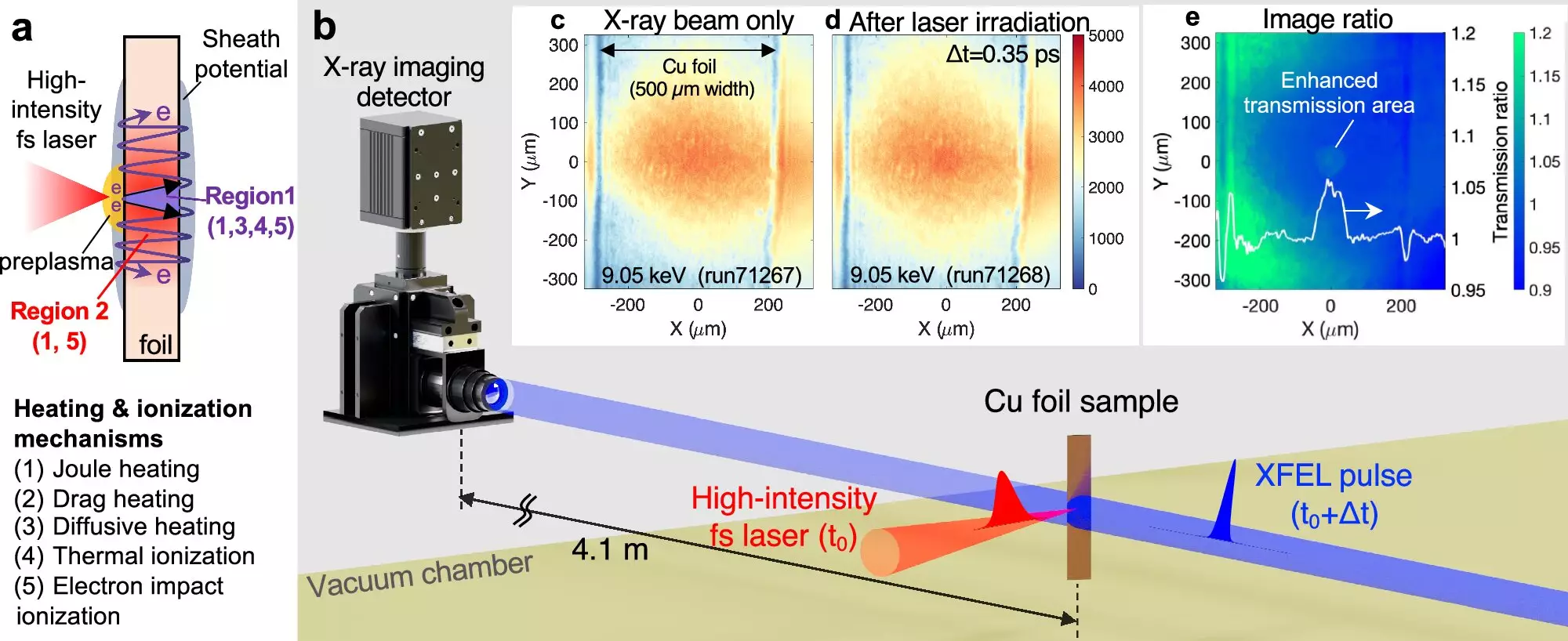The study of matter in extreme conditions has always captivated scientists, particularly in the realm of plasma physics. Recently, groundbreaking research has opened new avenues of understanding regarding the transition of materials like copper into unique states of matter when exposed to high-powered laser pulses. This phenomenon, especially in the context of “warm dense matter,” has implications not only for fundamental physics but also for practical applications in astrophysics and inertial fusion research.
The Transformation of Copper Under Intense Laser Pulses
In a remarkable series of experiments, researchers have observed that a small strip of copper can transform into a extremely hot state of plasma within picoseconds—trillionths of a second—when subjected to a powerful laser. At temperatures soaring near 200,000 degrees Fahrenheit, this transformation showcases the extreme dynamic behavior of materials under stress. The instantaneous shift from a solid to a plasma state presents a unique opportunity to investigate how heat propagates through metals at an unprecedented level of detail.
The research, spearheaded by Hiroshi Sawada at the University of Nevada, Reno, collaborated with an international team to utilize X-ray Free Electron Lasers (XFELs). This state-of-the-art technology allowed them to capture the rapid evolution of temperature and ionization in copper post-laser impact, significantly advancing our understanding of the fundamentals of plasma formation.
The methodological framework employed in this research involves intricate pump-probe experiments. By first exposing the copper to a high-intensity laser pulse (the pump), the researchers could then trigger an X-ray pulse (the probe) to capture real-time data on the resulting plasma state. This innovative approach has culminated in what is arguably the most precise collection of data concerning thermal dynamics within materials during such rapid transitions.
By systematically delaying the X-ray probe, the team could document the evolution of the copper’s temperature over time, essentially allowing them to “watch” how the material reacts to intense energy input. This time-resolved photography of heating dynamics has been pioneering, particularly because the scale of the observations—on the order of microns—is analogous to pinpointing the changes in a substance the width of human hair.
Before undertaking the experiments, researchers relied on computational models to predict how copper would behave under laser heating. Contrary to the anticipated transition to classical plasma, their experiments revealed that the copper did not behave as expected, instead existing in a warm dense matter state. This divergence between prediction and reality underscores the complexity of matter at extreme temperatures and densities—an area that is rife with surprises and necessitates further investigation.
Sawada’s astonishment at the findings illustrates the unpredictable nature of research at the nanoscale and highlights the necessity for experimental validation of theoretical models. The experimental data not only provides a crucial addition to the academic dialogue surrounding plasma physics but also serves as a foundation for future explorations into the complex behaviors of matter under extreme conditions.
The implications of these findings extend far beyond laboratory confines. Understanding heat transfer mechanisms in warm dense matter is critical for various fields, including astrophysics, where such states may mirror conditions found in the interiors of giant celestial bodies. Additionally, insights from this research can influence the development of laser-driven fusion energy, which holds the promise of more sustainable energy sources.
Moreover, the predictive capabilities and temporal resolution offered by XFELs, as employed in this study, pave the way for further explorations into the interplay between material defects and heat dynamics. Upcoming facilities, including next-generation XFELs, will harness these advancements to delve deeper into materials science and the fundamental principles of plasma behavior. This is particularly pertinent as researchers explore how different materials react under varying laser intensities, enriching the dialogue on material design for advanced technological applications.
The intersection of high-energy laser physics and warm dense matter research illuminates a frontier laden with potential. The collaboration among institutions is a testament to the collective effort required to unravel the complexities of matter under extreme conditions. As we peel back the layers of this field, we not only enhance our understanding of fundamental physics but also push the boundaries of what may be possible in energy, material science, and beyond.


Leave a Reply